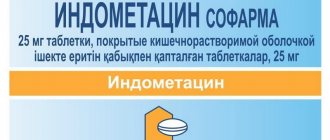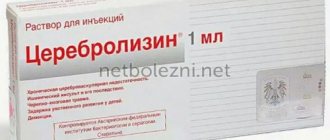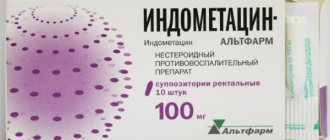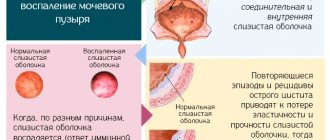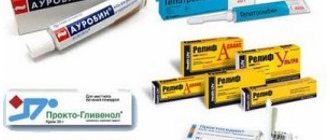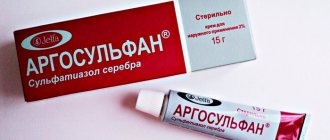Pharmacodynamics and pharmacokinetics
The active substance is indomethacin . The main component is a derivative of indoleacetic acid.
Methindol has analgesic and anti-inflammatory effects.
The antipyretic effect is associated with the process of non-selective suppression of the activity of cyclooxygenase-1,2, which are actively involved in the synthesis of prostaglandins.
The drug has an antiplatelet effect .
The drug in the form of a gel and ointment eliminates pain, swelling of the joints, morning stiffness, erythema, swelling around the joints, and allows you to expand the range of movements.
Pharmacokinetics
After oral administration, indomethacin is rapidly absorbed from the gastrointestinal tract. Cmax in plasma is reached after 2 hours. Metabolized in the liver. Subject to enterohepatic recirculation. Indomethacin is determined in the blood plasma in the form of unchanged substance and unbound metabolites - desmethyl, desbenzoyl, desmethyl-desbenzoyl.
T1/2 is about 4.5 hours. It is excreted in the urine - 60% in the form of unchanged substance and metabolites, and in feces - 33% mainly in the form of metabolites.
Indications for use
Instructions for use Methindol recommends prescribing the medication for pathologies of the musculoskeletal system of a degenerative and inflammatory nature: Personage-Turner disease (neuralgic amyotrophy), arthritis in Reiter's disease , Paget's disease, juvenile chronic arthritis, psoriatic arthritis, rheumatoid arthritis, ankylosing spondylitis ), rheumatism, gouty arthritis (except for acute attacks of gout).
The drug relieves pain: lumbago , toothache, after traumatic injuries and surgical interventions, headache, pain with tendonitis and bursitis , neuralgia , sciatica, myalgia.
The medication is indicated for the symptomatic treatment of pericarditis , secondary hyperaldosteronism ( Bartter's syndrome ), algodismenorrhea, patent ductus batallus, adnexitis, and inflammatory processes in the pelvis.
During the period of delivery, the medication is prescribed as a tocolytic and analgesic.
Methindol is indicated for otitis media, pharyngitis, tonsillitis and other infectious and inflammatory diseases of the ENT organs, accompanied by pain.
Indomethacin is prescribed for febrile syndrome (liver metastases of solid tumors, lymphomas, lymphogranulomatosis ) in the absence of a therapeutic effect from taking paracetamol and acetylsalicylic acid .
Methindol gel and ointment are prescribed for traumatic injuries of joints, ligaments, muscles, tendons (dislocations, sprains, bruises, stress). The drug is indicated for localized inflammation of soft tissues such as tendonitis, tendovaginitis, bursitis, and shoulder-arm syndrome. Ointment and gel are prescribed for myalgia, lumbago , sciatica, radiculitis , rheumatoid arthritis, deforming osteoarthritis, osteochondrosis with radicular syndrome, ankylosing spondylitis, glenohumeral periarthritis , psoriatic arthritis. The exception is degenerative pathology of small intervertebral and hip joints.
pharmachologic effect
A drug from the NSAID group, it has anti-inflammatory, analgesic, antipyretic and antiaggregation effects. Suppresses the activity of pro-inflammatory factors, reduces platelet aggregation. By inhibiting cycloxygenase 1 and 2, it disrupts the metabolism of arachidonic acid, reduces the amount of prostaglandins (Pg) both in the site of inflammation and in healthy tissues, and suppresses the exudative and proliferative phases of inflammation.
Causes a weakening or disappearance of pain syndrome of a rheumatic and non-rheumatic nature (including pain in the joints at rest and during movement, a decrease in morning stiffness and swelling of the joints, helps to increase the range of movements; in inflammatory processes that occur after operations and injuries, it quickly relieves both spontaneous pain and pain with movement, reduces inflammatory swelling at the wound site).
Contraindications
Methindol is not prescribed for congenital heart defects (severe tetralogy of Fallot, pulmonary atresia, severe coarctation of the aorta), peptic ulcer of the digestive tract, bleeding (from the gastrointestinal tract, intracranial), with the “aspirin” triad (medicine intolerance pyrazoline series and acetylsalicylic acid, recurrent polyposis of the paranasal sinuses and nose, bronchial asthma), with ulcerative colitis , liver cirrhosis with portal hypertension, with visual and color perception disorders, with arterial hypertension, swelling, chronic heart failure, bronchial asthma, optic nerve pathology , liver failure, blood clotting disorders (tendency to frequent bleeding, increased bleeding time, hemophilia ), during pregnancy, hematopoietic disorders (anemia, leukopenia), with pathology of the vestibular apparatus, decreased auditory perception, chronic pathology of the renal system, breastfeeding.
Rectal forms of the drug are contraindicated for hemorrhoids, rectal bleeding and proctitis. For elderly patients, children, depression, parkinsonism, epilepsy, thrombocytopenia, hyperbilirubinemia Metindol is prescribed with caution.
Ointment and gel are not prescribed to children under 1 year of age if the integrity of the skin is damaged.
When is use indicated?
Before prescribing the drug, the doctor assesses the risk-benefit ratio for each individual patient. The minimum possible dosage is used, which is necessary for the patient, taking into account his individual indications and health characteristics.
Methindol is prescribed in the following cases:
- Acute rheumatoid arthritis, including exacerbation of a chronic disease;
- Ankylosing spondylitis (Bechterew's disease);
- Osteoarthritis (large joints are affected, quite often the process spreads to the joints of the hands);
- Shoulder-carpal syndrome (bursitis, tendonitis);
- Gouty arthritis occurring in acute form.
Side effects
Digestive tract: disturbances in the liver system, diarrhea, epigastric pain, NSAID gastropathy , heartburn , vomiting, increased levels of liver enzymes, hyperbilirubinemia, decreased appetite, nausea. Long-term therapy may cause ulceration of the mucous membranes in the digestive system.
Sense organs: corneal clouding, visual disturbances, diplopia , auditory disturbances, tinnitus, changes in taste perception, conjunctivitis.
Nervous system: peripheral neuropathy , depression, increased drowsiness, fatigue, agitation, dizziness, irritability, headaches, insomnia .
Cardiovascular system: swelling, tachyarrhythmia , worsening chronic heart failure, increased blood pressure.
Urinary system: papillary necrosis, nephrotic syndrome , interstitial nephritis, disturbances in the renal system, hematuria, proteinuria .
Hemostasis system, hematopoietic organs: leukopenia, anemia (aplastic and hemolytic forms), bleeding (gingival, gastrointestinal, hemorrhoidal, uterine), eosinophilia, thrombocytopenia, thrombocytopenic purpura , agranulocytosis.
Allergic reactions: bronchospasm , angioedema, urticaria , skin itching , skin rash, anaphylactic shock, erythema nodosum , photosensitivity, Lyell's syndrome (epidermal, toxic necrolysis).
Changes in laboratory parameters: increased levels of potassium, agranulocytes, sugar, glucosuria, leukopenia, thrombocytopenia.
Local reactions: exacerbation of hemorrhoids, heaviness and discomfort in the anorectal area, itching, burning.
Other reactions include autoimmune hemolytic anemia, aplastic anemia , increased sweating, aseptic meningitis (in persons with autoimmune pathology).
Gel and ointment can cause exacerbation of psoriasis, rash and hyperemia at the site of application; with long-term treatment, systemic manifestations are possible.
Reviews
Alevtina, 45 years old “I have had back problems for a long time. When severe pain occurs, Methindol helps a lot. The doctor prescribed this drug to me. I try to take it for a short time, since I have gastritis, so I’m afraid of complications.”
Victor, 52 years old “Not so long ago, arthritis developed, the doctor prescribed Metindol. It’s a good drug, but there are a lot of side effects, but the pain goes away quickly.”
Do not self-prescribe and self-medicate, this can lead to irreparable consequences! Timely contact with a specialist will help avoid unwanted complications.
Methindol, instructions for use (Method and dosage)
Methindol is prescribed rectally, externally and internally.
At the initial stage, adults are prescribed 25 mg of indomethacin 2-3 times a day (after meals, washed down with milk). If ineffective, the amount of medication is increased to 150 mg per day (three times 50 mg).
According to the instructions for use, Methindol Retard is taken 1-2 times a day (1 tablet contains 75 mg of the active substance). No more than 200 mg per day. After achieving the desired effect, the amount of the drug is gradually reduced over 4 weeks.
The maximum daily dosage for long-term therapy is 75 mg.
Methindol is administered intramuscularly 1-2 times a day, 60 mg to relieve exacerbations of chronic processes and acute conditions. Intramuscular injections are given for 7-14 days, after which they switch to rectal or oral forms of administration.
Rectally, suppositories are administered 1-3 times a day, 50 mg as deeply as possible after complete emptying of the intestines before bedtime. For gout attacks, 200 mg per day is prescribed in suppositories (in addition to oral administration).
The gel and ointment are used exclusively externally, applied to the area of the affected joints 3-4 times a day, it is possible to apply occlusive dressings (but not recommended). For adults, the total amount of ointment should not be more than 15 cm per day, for children - 7.5 cm of ointment, squeezed out of the tube.
Use of the drug Methindol retard
Adults, including the elderly, are prescribed 1–2 tablets per day, depending on the clinical situation. The daily dose for children is 1.5–2.5 mg/kg body weight in 3–4 doses. The maximum dose is 150 mg/day. For primary dysmenorrhea, 1 tablet per day is prescribed until the end of menstruation. In patients with renal failure, a dose reduction is recommended to avoid accumulation of indomethacin. To reduce the risk of side effects from the digestive tract, you should take the drug with meals and a glass of water or milk. The tablets must be swallowed whole without chewing. It is recommended to start treatment with low doses, gradually increasing them if necessary. If you miss the next dose, you can take it within 2 hours after the scheduled time. If a dose is not taken within this time, you should skip it and take the next dose at the scheduled time. You cannot double the dose.
Overdose
It manifests itself as severe headaches, severe dizziness, vomiting, memory impairment, nausea, disorientation in time and space.
In severe cases, convulsions, paresthesia , and limbs become numb.
Emergency removal of the drug from the human body is required; further tactics are based on symptomatic therapy.
Hemodialysis has not proven effective. A specific antidote has not been developed.
Dosage form and composition of Methindol
- Pills. One pill contains 75 mg of Indomethacin. Packaging contains 25 or 50 tablets;
- Rectal suppositories. The active ingredient is the same as in tablet form, in the preparation - 0.05 and 0.1 g;
- Solution for injection - in an ampoule of 2 ml, in a package - 10 pieces;
- Ointment. One gram of the drug contains 50 mg of indomethacin; in tubes - 30 g.
Interaction
The severity of nephrotoxic effects increases when used together with paracetamol. The drug increases the level of methotrexate , drugs with lithium ions, digoxin, which leads to an increase in the severity of their toxic effects. Glucocorticosteroids, colchicine, corticotropin, ethanol increase the risk of gastrointestinal bleeding . The medication enhances the hypoglycemic effect of oral hypoglycemic agents, insulin; increases the effectiveness of antiplatelet agents , indirect anticoagulants, thrombolytics (urokinase, alteplase, streptokinase); bleeding is possible.
Methindol increases the side effects of MCS, estrogens, glucocorticosteroids , acetylsalicylic acid, NSAIDs.
The drug reduces the effect of diuretics.
The risk of hyperkalemia increases significantly when taking potassium-sparing diuretics .
Indomethacin can reduce the effectiveness of antihypertensive and uricosuric drugs.
Due to the suppression of prostaglandin synthesis in the kidneys, nephrotoxicity increases when taking Au drugs and cyclosporine .
Absorption of the main substance is reduced when taking cholestyramine and antacids.
Plicamycin, cefotetan, cefamandole, valproic acid , cefaperazone increase the risk of bleeding and increase the incidence of hypoprothrombinemia .
Hematotoxicity increases with simultaneous therapy with myelotoxic drugs.
By inhibiting metabolism, Methindol increases the toxicity of zidovudine .
The drug increases the risk of toxic effects from the use of aminoglycosides in newborns (by increasing the concentration of the active substance in the blood and reducing renal clearance ).
Interactions of the drug Methindol retard
The risk of side effects increases with simultaneous use of Methindol retard with diflunisal, acetylsalicylic acid and other salicylic acid derivatives, paracetamol, methotrexate, anticoagulants, and thrombolytic agents. Combination with antidiabetic drugs, probenecid, β-adrenergic receptor blockers, corticosteroids, corticotropin, myelosuppressive drugs, lithium salts, thiazide diuretics and furosemide, triamterene, cefamandole, cefoperazone, cefotetan, plicamycin, cyclosporine, valproic acid and gold compounds is undesirable.
special instructions
Methindol is discontinued 48 hours before determining the level of 17-ketosteroids.
During the treatment period, monitoring of the functional state of the hepatic and renal systems and peripheral blood .
The use of antacid medications can reduce and prevent dyspeptic disorders caused by taking indomethacin.
Methindol is capable of influencing the control of complex mechanisms and vehicles.
It is necessary to avoid contact of Methindol ointment and gel with mucous membranes, eye area, and damaged tissues.
Drug interactions
Reduces the effectiveness of uricosuric drugs, antihypertensive and diuretics (saluretics); enhances the effect of indirect anticoagulants, antiplatelet agents, fibrinolytics, side effects of mineralocorticosteroids, estrogens, and other NSAIDs; enhances the hypoglycemic effect of sulfonylurea derivatives.
Combined use with paracetamol increases the risk of nephrotoxic effects. Ethanol, colchicine, glucocorticosteroids - increase the risk of developing gastrointestinal complications accompanied by bleeding.
Increases the concentration of lithium, methotrexate and digoxin in the blood. Cyclosporine and gold preparations increase the nephrotoxicity of indomethacin. Cefamandole, cefoperazone, valproic acid - increase the risk of developing hypoprothrombinemia and the risk of bleeding. Reduces the elimination of penicillins. Potentiates the toxic effect of zidovudine.
Methindol's analogs
Level 4 ATC code matches:
Voltaren Emulgel
Ultrafastin
Indomethacin
Dicloran
Dicloran Plus
Dolgit
Nise
Ketonal
Ketorol
Febrofeed
Fastum gel
Diclofenac
Finalgel
Bystrumgel
Deep Relief
Butadion
Diklovit
Artrosilene
Olfen
Fanigan Fast
Analogues are drugs containing the active component indomethacin.
